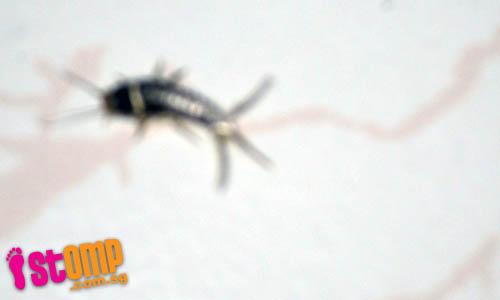
STOMPer Dickson was disturbed to find this bizarre creature crawling around on the floor. He sent in a video hoping someone would know what it was.
Here's what the STOMPer wrote in an email today (July 23):
"What is this creature?
"Is it some kind of new bug or something else?
"Tell me please."
Do check out the video posted on STOMP.
It appears that this is a silverfish (F. Lepismatidae), but the video quality is simply too lousy to discern any identifying features that would help in narrowing down the species.
It is possible that it is a common silverfish (Lepisma saccharina), a cosmopolitan species that can be found in homes all over the world.

Common silverfish;
(Photo by misterjingo)
The silverfish gets its name partly due to its smooth silvery appearance, as well as the tiny scales that cover its body.
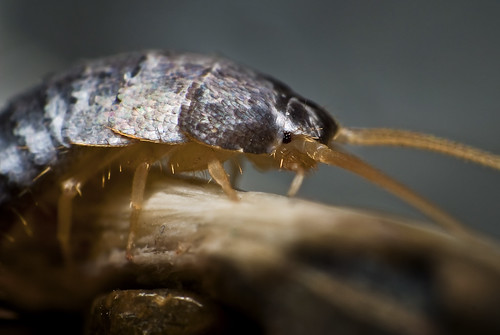
Common silverfish;
(Photo by johnhallmen)
Silverfish like dark, cool and damp places, so it is not uncommon to encounter them hiding inside cupboards where dried foodstuffs or books are kept, or beneath sinks. They feed largely on substances containing starch, which includes all sorts of items, such as glue, book bindings, paper, cereals, sugar, and even hair and dandruff. This helps explain why silverfish are often seen hiding among old books or piles of old newspapers. Apparently they can survive for up to a year without food.
These insects can become pests and cause serious damage to books and textiles, but do not pose any threat to human health. However, their feeding habits pose a challenge for those who wish to preserve and maintain old books, works of art and other items of cultural significance in good condition.
I suppose the risk of damage to books because of silverfish infestation is a major reason why libraries in Singapore are so unbearably cold. The lowered temperature and humidity must make it more challenging for undesirable organisms (silverfish included) from establishing themselves and reproducing.

Common silverfish;
(Photo by keith tooley)
Silverfish belong to the family Lepismatidae, which in turn are the largest family in a very primitive group of insects known as the Zygentoma. Zygentomans are among the most primitive living insects; only the bristletails (Microcoryphia) are thought to be more basal. These 2 groups were once classified with other tiny 6-legged arthropods such as the springtails (Collembola), proturans (Protura) and two-pronged bristletails (Diplura), and this group was known as Apterygota, as members of this group lacked wings at all stages of their lives. However, more recent research shows that such a grouping is artificial, and that while bristletails and silverfish are very primitive insects, the other 3 groups fall outside of the Insecta.
The common silverfish is not the only species in its family that is adapted to living in our homes. A close relative of the common silverfish is known as the firebrat (Thermobia domestica), and it prefers much warmer places than the silverfish. Hence, this insect can be found living close to ovens, furnaces, fireplaces and water heaters.
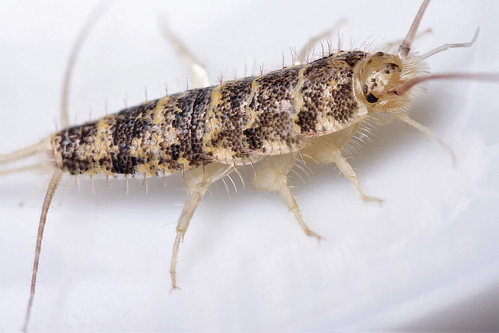
Firebrat;
(Photo by Mundo Poco)
While doing research for this post, I found out that the common silverfish and firebrat are not the only species that can be found living in homes.
There is the four-lined silverfish (Ctenolepisma lineata).
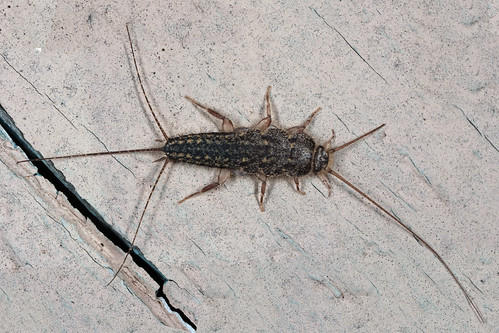
Four-lined silverfish;
(Photo by Goshzilla - Dan)
There is also a species known as the grey silverfish (Ctenolepisma longicaudata).
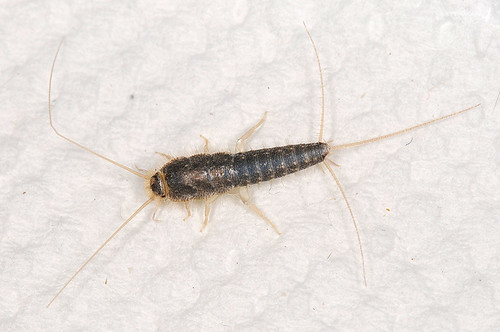
Grey silverfish;
(Photo by Bettaman)
The grey silverfish bears a very close resemblance to the common silverfish, but grows to a larger size, reaching 19 millimetres in length compared to the common silverfish, which maxes out at about a centimetre or so. There are several other anatomical details that can be used to differentiate the various species. For example, common silverfish have broad and flattened femora (the first segment of the leg), whereas the grey silverfish is somewhat stout-bodied compared to the slender build of the common silverfish. Unfortunately, these details can be hard to spot in such tiny insects.

Grey silverfish;
(Photo by Bettaman)
Because of this, I suspect that the insect in the video is a grey silverfish, since it does appear to be quite large compared to the silverfish I used to find in my cupboards. Still, given the quality of the video, it is difficult to make such a conclusion with any certainty. I don't even know if the grey silverfish is present in Singapore or not.
Silverfish are not the only insects that a bibliophile should worry about; the Psocoptera has several wingless members that are commonly known as booklice. These tiny insects belong to the family Limnoscelidae, in the genus Limnoscelis. Like silverfish, they can be found in homes worldwide, where they nibble on the paste used in book bindings. They can also be found hiding beneath peeling wallpaper, or feeding on flour and other cereal products.

One species of booklouse in particular, Liposcelis bostrychophila, has a worldwide distribution;
(Photo by Alby Oakshott)
A wide variety of arthropods have adapted to living in our homes, so much so that it can be impossible to find them living in a so-called 'natural' or 'wild' state. We are familiar with various species of cockroach, flies and ants, but we tend to overlook the multitude of other critters that find a ready source of food and shelter in our homes.
For many of them, it just so happens that we have an abundance of the food they have specialised to munch on. Various species of beetles, moths and mites are significant pests, feeding on food products to clothes, carpets, and furniture. Some beetles are especially partial to museum specimens, and can ruin entire collections of insects or furs. These in turn attract a host of predators, such as spiders, centipedes and pseudoscorpions.
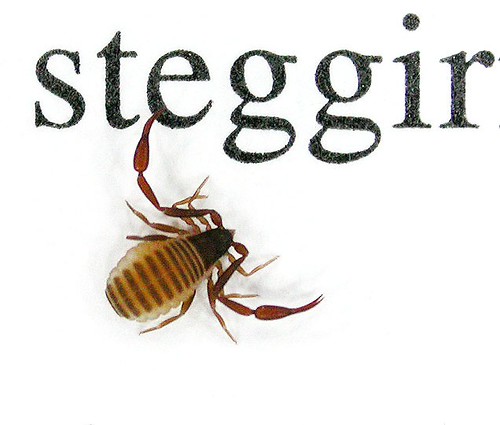
Chelifer cancroides is a cosmopolitan species of pseudoscorpion that can be encountered in the home, where it feeds on mites and tiny insects;
(Photo by Erling Ólafsson)
Like it or not, our homes form an entire unique ecosystem, full of tiny creatures living in our midst. Given the worldwide distribution of many of these species, it would be interesting to study how they managed to colonise new areas, usually by hitching a ride as we move goods and cargo to and fro. The growth and development of transportation networks all over the world has certainly assisted in the spread of these little commensals.